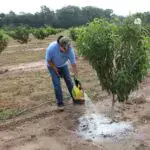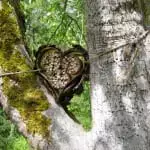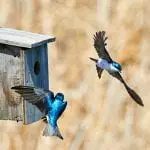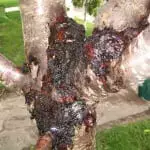Learn how beneficial nematodes can help you protect your fruit trees from plum curculio and other pests.
Identify Fruit Tree Leaf Problems: A Gardener’s Guide

how fruit tree leaf problems indicate tree health
Autumn is on the way, and here in Ontario we're just starting to see those beautiful leaf colours in vibrant shades of red, yellow, and orange. Leaves notify us that the winter is approaching as the trees draw nutrients out of their leaves and into their roots for winter storage. But all through the growing season, leaves tell us a lot more than that. Tree leaves tell us about problems with tree health.
Last year, for instance, I noticed that the leaves on a beautiful sugar maple in our local park turned yellow. If it happened in October, I wouldn't have worried. The problem was that all the leaves on that tree changed colour in July! It was a hot summer, and winter was months away.
So I went closer and saw that something else was going on. The leaves were yellow with brown blotches moving in from the edges and tips. This is called leaf necrosis: it means the leaves are dying, and if nothing is done, the tree could die too.
Leaf necrosis is a classic sign of drought stress. This summer was very hot and dry. And some types of maple trees are shallow rooted, so they experience drought stress before other trees. They are like the canary in the coal mine, and their symptoms tell us to get busy watering if we want our beautiful trees to survive and thrive.
Leaves can tell us so much about tree health. In addition to signaling drought stress in maples, fruit trees can suffer from necrosis caused by dehydration too. However, fruit trees often exhibit a wider range of leaf problems, including nutritional deficiencies and pest or disease issues. Our job as gardeners is to recognize these symptoms and fulfill our trees' needs before it's too late.
Fruit Tree Leaf Problems: Drought stress
When brown blotches are working their way in from the edges and tips of your tree’s leaves, it’s very likely to be drought stress. But what’s causing the problem? If it’s a dry summer, it may just mean that you need to water your tree. But these symptoms can also result from too much salt in the soil.
Either way, once you see those blotches appearing, it’s time to take action! Set up a soaker hose and give your tree a long, slow water once a week or so to restore tree health. Water will also help wash excess salt out of the soil. Be sure to let the soil dry out before watering again.
If you have an apple or pear tree, be careful not to confuse drought stress with a quickly spreading disease called fireblight. With this nasty bacterial disease, the leaves don’t get blotchy - rather, they look burnt, and entire branches die back starting from the tender branch tips.
If you see this, carefully prune off infected branches back to the trunk and put them in garbage bags - they should go in the garbage, not in the compost. Then sterilize your pruners with rubbing alcohol before using them again on any other tree.

Fruit Trees
That Thrive
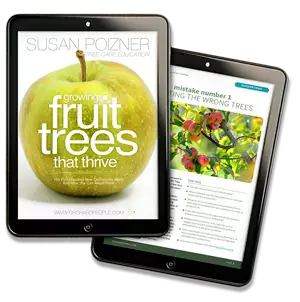
Fruit Tree Leaf Problems: Nutritional deficiencies
Late last summer, I took a walk in a nearby arboretum and saw a very unusual looking hickory tree. Instead of being green, its leaves were striped with yellow! It was beautiful, but sadly this hickory tree was experiencing a serious problem.
Interveinal chlorosis is when your leaf goes yellow, but only in between leaf veins. The leaf veins remain green. This is usually a sign that the tree doesn’t have enough manganese or iron, both essential nutrients when it comes to tree health and photosynthesis.
There are a number of reasons why this may be happening. Those nutrients may be lacking in the soil. Or, it could be a pH problem.
pH, or soil acidity, influences how easy it is for a plant to take up nutrients from the soil. If the pH is wrong, it’s like going to an all-you-can eat buffet with your hands tied behind your back. The food is there - you just can’t get at it.
Alternatively, this problem could be the due to too much phosphorus in the soil. While phosphorus is an important nutrient for healthy plant growth, having too much of it is toxic to plants. This may result from the over-application of fertilizers.
So, how can you tell what is responsible for the problem? Learn to identify signs of nutrient deficiencies in leaves in our podcast on how to identify fruit tree nutrient deficiencies.
Or you can get a soil test. It will tell you the levels of iron, manganese, phosphorus, and more. Then you can help your tree by amending the soil according to the lab’s instructions.
Sometimes you’ll see a leaf turn completely yellow during the growing season, including the veins. This is called chlorosis, and it could be a sign of nitrogen deficiency.
Soil tests are rarely good indicators of nitrogen in the soil, since nitrogen levels are constantly changing. In this case, consider amending your tree’s soil with quality compost in the spring or summer to see if that helps.
The other problem with fruit trees is that owners often sometimes over fertilize their fruit trees (which can cause leaf necrosis) or they don't fertilize them at all! You can avoid those problems with correct mulching (arborist wood chips can be great or there are lots of other fruit tree mulch options) or even by using homemade fertilizer sprays.
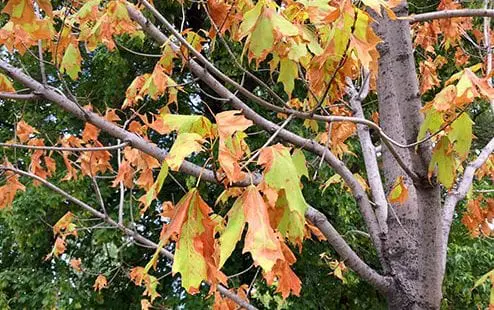
Fruit Tree Leaf Problems: Disease
In Ben Nobleman Park in Toronto, where I planted a community orchard in 2009, I learned my lesson about disease on leaves early on. In the first year, I saw a few orange spots on the leaves of one of our young pear trees. I ignored them.
The next year there were more spots and this time on all three of our pear trees. By the end of that summer, the trees were covered with orange spots, and looked like three miserable kids covered with chicken pox.
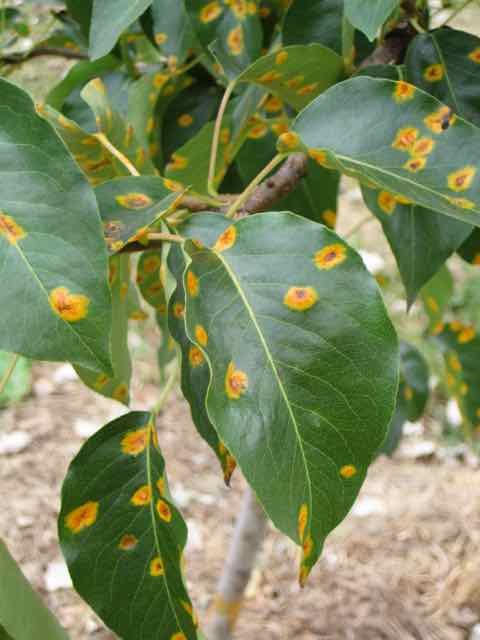
Only then did I do my research. I discovered that our pear trees were infected with a fungal disease called pear trellis rust.
But that’s just one of the spotty diseases that trees can experience. Over the years I’ve seen all sorts of trees with unhappily spotted leaves. They may be big or small, brown or green or red, but they are never a good sign. Often they are fungal diseases.
The important thing to know is that if you see any unusual spots on the leaves of your tree, you should research the problem early on. Some fungal diseases can be nipped in the bud with applications of an organic fungicide like garden sulphur.
In Ben Nobleman Park, by the time we acted, it was too late. Our young pear trees were too weak and stressed and would never fully recover. We dug them out and planted apple trees instead.

Fruit Tree Leaf Problems? Pest damage
Finally: pests. You've got to admit, some of them are really crafty. Some, like Japanese beetles, turn our trees leaves into these beautiful lace patterns as they nibble away. Others create horrible seething tents of larvae (think of tent caterpillars) that feed on young leaves.
Some problems are more subtle. If a leaf looks unhealthy, pluck it off and hold it up to the sun so you can see through it. You may see a leaf miner tunneling through the leaf leaving frass (insect larvae poop) in brown blotches here and there.
What do you do with pests? Look them up online, and then choose your option. You can smoosh them as you see them. You can burn them (an option for tent caterpillars). Or if there’s just a few insect problems, you can also leave them. After all, those pests are trying to survive – just like we humans are.
Learn how expert growers keep their fruit trees healthy in my instant-access, online fruit tree care courses at Learn.OrchardPeople.com.

Susan Poizner
Learn more about Susan on the about us page.
